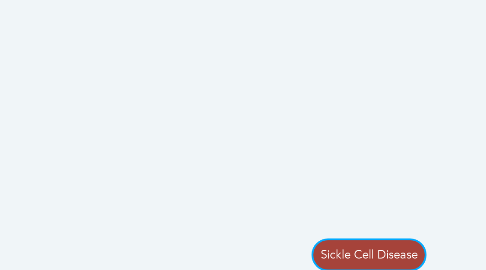
1. Pathophysiology
1.1. Sickle cell disease is a complex genetic blood disorder that affects the structure and function of hemoglobin.
1.1.1. Altered hemoglobin reduces the ability of red blood cells to transport oxygen efficiently.The mutated variant of the the β-globin gene is inherited, leading to the production of hemoglobin S (HbS).
1.1.1.1. Red blood cells assume a sickled shape when oxygen levels are low. Patients affected by the disease must receive a mutated gene from each parent as SCD is an autosomal, recessive disorder.
1.1.1.1.1. Sickled cells have a decreased survival time, which causes anemia and vascular occlusion. Capillary stasis, venous thrombosis, and arterial emboli are frequent complications of SCD.
2. Etiology
2.1. The etiology of SCD is not well understood but given that it is an inherited condition The sickle mutation of the β-globin gene produces an abnormal hemoglobin called sickle hemoglobin S (HbS).
2.1.1. In hemoglobin S, valine is substituted for glutamic acid in the sixth position of the β-chain, rather than the normal configuration.
2.1.1.1. Under decreased oxygen tension, When hemoglobin S undergoes polymerization under decreased oxygen tension, it causes the sickling of red blood cells.
2.1.1.1.1. Patients who are homozygous produce only hemoglobin S. No hemoglobin A is synthesized because all the chains that should be β-chains are now S-chains (NHLBI, 2020).
3. Clinical Manifestations
3.1. The manifestations and severity of SCD vary significantly from individual to individual and signs and symptoms are often categorized as acute or chronic.
3.1.1. Chronic hemolytic anemia, recurrent episodes of pain, as well as acute and chronic organ dysfunction are the cardinal features of sickle cell disease.
3.1.1.1. Painful crises are a result of obstruction of blood vessels, tissue hypoxia, and tissue death.
3.1.1.1.1. Children with SCD may experience growth and puberty delays but will typically achieve normal height in later adolescents.
4. Management and Treatment
4.1. Blood and bone marrow transplants are the only currently approved cures for patients suffering from SCD. Although these options may not be suitable for everyone.
4.1.1. There are no safe, effective antisickling agents on the market yet, so treatment is primarily supportive.
4.1.1.1. Avoiding exacerbating agents of SCD crisis is also critical to managing the disease. Some known causative agents are: dehydration, infection, fever, acidosis, hypoxemia, and cold exposure.
4.1.1.1.1. It is also highly recommended that persons with SCD receive regular vaccinations as this can help decrease their risk of complications.
